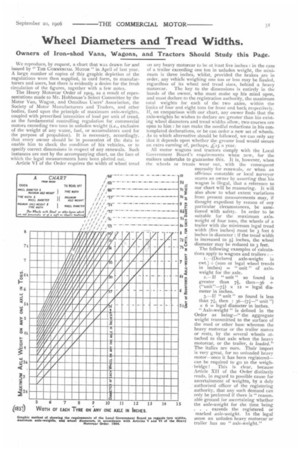Wheel Diameters and Tread Widths.
Page 7

If you've noticed an error in this article please click here to report it so we can fix it.
Owners of Iron-shod Vans, Wagons, and Tractors Should Study this Page.
We reproduce, by request, a chart that was drawn for and issued by " THE COMMERCIAL MOTOR" in April of last year. A large number of copies of this graphic depiction ot the regulations were then supplied, in card form, to manufacturers and users, but there is evidently a desire for the fresh circulation of the figures, together with a few notes. The Heavy Motorcar Order of 1904, as a result of representations made to Mr. Hobhouse's Select Committee by the Motor Van, Wagon, and Omnibus Users' Association, the Society of Motor Manufacturers and Traders, and other bodies, fixed upon the principle of maximum axle-weights, coupled with prescribed intensities of load per unit of tread, as the fundamental controlling regulation for commercial motors exceeding two tons in unladen weight (i.e., exclusive of the weight of any water, fuel, or accumulators used for the purpose of propulsion). It is necessary, accordingly, that every owner should be in possession of the data to enable him to check the condition of his vehicles, or to specify correct dimensions in respect of any renewals. Such instances are met by the accompanying chart, on the face of which the legal measurements have been plotted out.
Article VI of the Order requires the width of wheel tread
.. .... .
.—A
....
on an■ heavy motorcar to be at least five inches : in the case of a trailer exceeding one ton in unladen weight, the minimum is three inches, whilst, provided the brakes are in order, any vehicIe weighing one ton or less may be fiaukx1, regardless of its wheel and tread sizes, behind a heavy motorcar. The key to the dimensions is entirely in the hands of the owner, who must make up his mind upon, and must declare to the registration authority, the maximum total weights for each of the two axles, within the limits of four and eight tons for front and back respectively. If, on comparison with our chart, any owner finds that the axle-weights he wishes to declare are greater than his existing wheel diameters and tread widths allow, two courses are open to him : he can make the needful reductions in his contemplated declarations, or he can order a new set of wheels. As to which alternative should be followed, we can only say that it depends upon whether the greater load would secure an extra earning of, perhaps, £15 a year.
All motor wagons and tractors comply with the Local Government Board's requirements when new, for the makers undertake to guarantee this. It is, however, when
the wheels or treads wear out, with the consequent necessity for renewals, or when an officious constable or local surveyor scares an owner by asserting that his wagon is illegal, that a reference to our chart will be reassuring. It will also show to what extent variations from present measurements may, if thought expedient by reason of any particular circumstances, be sanctioned with safety. In order to be suitable for the maximum axleweight of four tons, the wheels of a trailer with the minimum legal tread width (five inches) must be 3 feet 6 inches in diameter : if the tread width is increased to sa inches, the wheel diameter may be reduced to 3 feet. The following examples of calculations apply to wagons and trailers :—
I. —(Declared axle-weight in cwt.) + (sum of legal wheel treads in inches) = " unit " of axle weight for the axle.
unit" so found is greater than 7, then-36 + ("unit"-71) x 12 = legal diameter in inches.
3.—If " unit " so found is less than 7?i, then : 36—(7I—" unit ") x 6 = legal diameter in inches. " Axle-weight " is defined in the
Order as being—" the aggregate weight transmitted to the surface of the road or other base whereon the heavy motorcar or the trailer moves or rests, by the several wheels attached to that axle when the heavy motorcar, or the trailer, is loaded." The italics are ours. Their import is very great, for no unloaded heavy motor—once it has been registered— can be required to go to the weigh
, bridge ! This is clear, because Article XII of the Order distinctly reads, in regard to possible cause for ascertainment of weights, by a duly
• authorised officer of the registering authority, that any such demand can only be preferred if there is "reasonable ground for ascertaining whether the axle-weight for the time being . . . exceeds the registered or marked axle-weight. In the legal sense an unladen heavy motorcar or trailer has no "axle-weight."
























